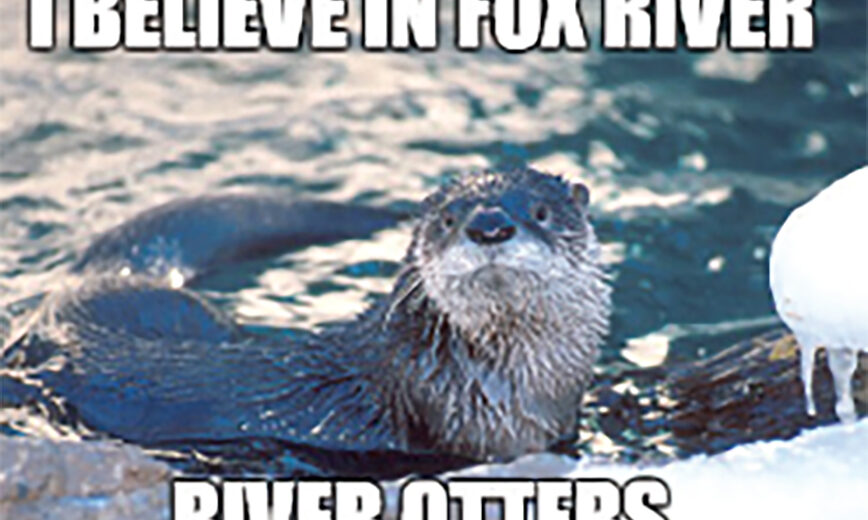December 12, 2014
Otters
One of the more common images making its way around Facebook these days depicts a quintessential Santa Claus. With a plate of cookies in one hand and a glass of milk in the other, St. Nick appears just as we followers have always pictured him: twinkling eyes, merry dimples, nose like a cherry… If you’ve ever read The Night Before Christmas, you know what I mean.
Across the bottom of the picture, in bold print, are the words “Share if you believe in Santa Claus.”
In Facebook fashion, lots and lots of folks have done just that—just over 900,000 believers, the last time I checked.
I was tempted to declare my belief as well. After all, Christmas is less than two weeks away. What harm could it do? Heck, it might even mean an extra candy cane or two in my stocking on Christmas morning. But then I stopped myself. Another thought, one of an even greater magnitude, rose up and quickly eclipsed any inclination to share my beliefs about a Jolly Old Elf.
While I’m pretty sure there’s a Santa Claus, in a goodwill and holiday-spirit sort of sense, I’m absolutely, 100% positive of another, more local phenomenon. I believe in Fox River river otters.
I know, it sounds weird to rank Lontra canadensis at the same level as the one and only Santa Claus. In fact, to the casual observer, it may seem like we’ve had river otters all along. Brown mammals paddling through water actually are pretty common in our area. But these critters, on closer examination, generally turn out to be beavers, muskrats or mink. To gain a little perspective on just how fantastic my belief is, maybe we “otter” take a look at the history of otters in Illinois.
According to the Illinois Department of Natural Resources, these animals once were abundant throughout our state. But things changed rapidly after European settlement began. Prized for their rich, dense fur, otters were hunted; overhunted, in fact. At the same time, their riverine habitats were altered. Streams were dammed; pollution began to build.
By the early 1900s, river otters were considered rare in Illinois. In 1929, state officials closed the otter trapping season. Throughout the 1930s, ’40s and ’50s, the animals retreated farther, taking refuge primarily in two areas that still provided suitable habitat—along the Mississippi River in northwest Illinois, and the Cache River down south.
Although the first step toward otter recovery—the passage of the Clean Water Act—occurred in1970, it would be several more years before the species would begin to rebound. In 1977 river otters were declared threatened in Illinois; this status was downgraded to endangered in 1989. IDNR officials estimate that fewer than 100 otters lived in Illinois at that time.
But as the polluted waters that were rampant prior to 1970 began to clear, conditions for fish—the carnivorous river otters’ primary prey—began to improve. Beavers, too, came back, and began recreating the wetland habitat otters find appealing.
By the early 1990s, the idea of reintroducing river otters to Illinois waters began to appear feasible. Studies were conducted, plans were made. Starting in 1994, wildlife biologists began relocating otters from Louisiana to Illinois. This effort continued for three years, during which a total of 346 otters were released in central and southeastern Illinois.
It wasn’t long before these few individuals grew to several, then lots. Concurrently, otters from recovery projects in nearby states found Illinois to their liking too. In 1999, the animal’s status was upgraded from state endangered to state threatened, then delisted entirely in 2004.
IDNR figures indicate that there were 11,000 otters in Illinois in 2009. At that time, the population was projected to grow to more than 30,000 by 2014.
Which brings us up to the present day. While I wasn’t able to find super-recent numbers, I do know that the state reinstituted an otter trapping season in 2012. And, over the past few years, I’ve heard anecdotes—some more reliable than others–of otter sightings along the Fox River and its tributaries. The most recent of these occurred just the other day, on Kane County Audubon’s web site. One report of a bald eagle along the Fox River also included reference to a kayaker who said he saw river otter near Judson University in Elgin.
Okay, I know this is second-hand information at best. Third-hand is more like it. But, still, it’s a mention of yet another animal that, only a few decades ago, we thought might be gone for good from our area.
Bald eagles are a species that also fits into this category; so are sandhill cranes. Shoot, let’s add cougars to that list of possible sightings too.
And, given the time of year, Santa. I just looked at Facebook again, and he’s up to 951,765 “shares.” That’s a lot of support for a fellow whose main mode of transportation is a sleigh pulled by flying reindeer. But like any true believer will tell you, all you’ve got to do is have faith.
How about you? Do you believe in Santa Claus? River otters? Fox River river otters, specifically?
I know I do.
Pam Erickson “Otter” Otto is the manager of nature programs and interpretive services at the Hickory Knolls Discovery Center, a facility of the St. Charles Park District. She can be reached at 630-513-4346 or potto@stcparks.org.

